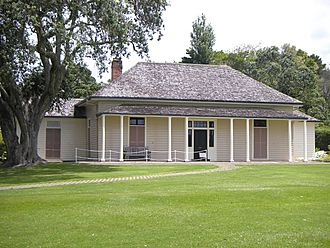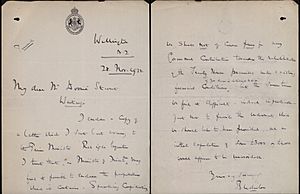Treaty House facts for kids
Quick facts for kids Treaty House |
|
|---|---|
|
Whare Tiriti
|
|

The restored Treaty House (2006)
|
|
| General information | |
| Coordinates | 35°15′57″S 174°04′54″E / 35.2658°S 174.0816°E |
| Designated: | 23 June 1983 |
| Reference #: | 6 |
The Treaty House (called Whare Tiriti in Māori) is a very important historical building in Waitangi, New Zealand. It was once the home of James Busby, who was the British Resident. This means he was the official representative for Britain in New Zealand.
The most famous event at the Treaty House happened on 6 February 1840. On its grounds, the Treaty of Waitangi was signed. This document was a major agreement that led to New Zealand becoming a British colony.
Before the Treaty was signed, another important event took place here in 1835. The Declaration of the Independence of New Zealand was signed on these same grounds. This document declared Māori chiefs as leaders of New Zealand.
The house and its land were privately owned for many years. In 1932, a special person named Viscount Bledisloe bought them. He was the Governor-General, a high-ranking official. He then gave the property to the nation as a gift.

In 1934, the Treaty House and its grounds became a national reserve. A huge ceremony was held, with thousands of people attending. Both Māori and Pākehā (New Zealanders of European descent) were there. Even the Māori King attended this special event.
The Treaty House was also the center of celebrations in 1940. This marked 100 years since the Treaty was signed. Since 1947, the grounds have been the main place for annual Waitangi Day celebrations. This day remembers the signing of the Treaty.
Contents
Building the Treaty House
The Treaty House was built for James Busby and his family. Construction happened between 1833 and 1834. It is one of the oldest buildings still standing in New Zealand today.
Original Design and Size
When it was first built, the house had two main rooms. It also had an entrance hallway and a verandah (a covered porch). A separate building at the back held the kitchen and a room for servants. Busby thought the house was too small for his important role. However, for New Zealand in the 1830s, it was actually a large home.
Changes and Repairs Over Time
The house was made bigger in the 1830s and 1840s. A lean-to (a small addition) and two wings were added. The Busby family owned the property until 1882. Then, a local farmer bought it. For some years, it was used for farming, even for shearing sheep.
The house started to fall apart over time. People tried to get the government to buy it. These efforts finally worked in 1932 when Viscount Bledisloe bought it. After that, a famous architect named William Henry Gummer restored the house. This was one of the first big government projects to restore a historic building in New Zealand.
In the late 1980s, more work was done on the house. This was to get it ready for the 150th anniversary of the Treaty signing in 1990. The goal was to make the house look more like it did in 1840.
A Special Heritage Site
The Treaty House is a very important heritage site. Since 1983, it has been listed as a Category I building by Heritage New Zealand. This means it is a place of great historical importance.
What You Can See Today
Inside the Treaty House, there is a museum. It teaches visitors about the Treaty of Waitangi. It also shows what life was like in the house in the mid-1800s.
The grounds around the house are also very special. You can see a beautifully carved whare runanga. This is a traditional Māori meeting house. There is also a large waka taua, which is a war canoe. Its name is Ngā Toki Matawhaorua. Both the meeting house and the canoe were built for the 1940 celebrations.
A flagstaff stands on the exact spot where the Treaty was signed. The first flagstaff was put up by the New Zealand Division of the Royal Navy just before the 1934 Waitangi Day celebrations. Nearby, you can also find the Waitangi Treaty Monument. This monument was built around 1880–1881 and is also a Category 1 heritage item.
Images for kids
-
Treaty House photographed in 1912 by Henry Winkelmann





